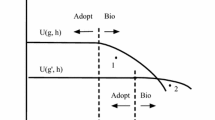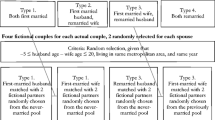Abstract
We used 1990 Census data to compare the matching behaviors of four types of cohabiting couples: same-sex male couples, same-sex female couples, opposite-sex unmarried couples, and married couples. In general, we found evidence of positive assortative mating for all traits and across all types of couples. The positive assortative mating, however, is stronger for non-labor-market traits (e.g., age, education) than for labor-market traits (e.g., hourly earnings). Further, members of married couples are more alike with respect to most characteristics than are members of opposite-sex cohabiting couples, and members of opposite-sex cohabiting couples are more alike than are members of same-sex couples.
Similar content being viewed by others
References
Allegretto, S.A. and M.M. Arthur. 2001. “An Empirical Analysis of Homosexual/Heterosexual Male Earnings Differentials:Unmarried and Unequal?” Industrial and Labor Relations Review 54:631–46.
Badgett, M.V.L. 1995. “The Wage Effects of Sexual Orientation Discrimination.” Industrial and Labor Relations Review 48:726–39.
Badgett, M.V.L. and R.M. Williams. 1992. “The Economics of Sexual Orientation: Establishing a Research Agenda.” Feminist Studies 18:649–60.
Bailey, J.M., P.Y. Kim, A. Hills, and J.A.W. Linsenmeier. 1997. “Butch, Femme, or Straight Acting? Partner Preferences of Gay Men and Lesbians.” Journal of Personality and Social Psychology 73:960–73.
Becker, G.S. 1974. “A Theory of Marriage.” Pp. 299–344 in Economics of the Family: Marriage, Children, and Human Capital, edited by T.W. Schultz. Chicago: University of Chicago Press.
—. 1991. A Treatise on the Family. Cambridge, MA: Harvard University Press.
Bergstrom, T.C. and M. Bagnoli. 1993. “Courtship as a Waiting Game.” Journal of Political Economy 101:185–202.
Black, D.A., G. Gates, S.G. Sanders, and L. Taylor. 2000. “Demographics of the Gay and Lesbian Population in the United States:Evidence From Available Systematic Data Sources.” Demography 37:139–54.
—. 2002. “Why Do Gays Live in San Francisco?” Journal of Urban Economics 51:54–76.
Black, D.A., H.R. Makar, S.G. Sanders, and L. Taylor. Forthcoming. “The Effects of Sexual Orientation on Earnings.” Industrial and Labor Relations Review.
Blackwell, D.L. and D.T. Lichter. 2000. “Mate Selection Among Married and Cohabiting Couples.” Journal of Family Issues 21:275–302.
Blumstein, P. and P. Schwartz. 1983. American Couples. New York: William Morrow and Company, Inc.
Boyden, T., J.S. Carroll, and R.A. Maier. 1984. “Similarity and Attraction in Homosexual Males: The Effects of Age and Masculinity/Femininity.” Sex Roles 10:939–48.
Bumpass, L.L. and J.A. Sweet. 1989. “National Estimates of Cohabitation.” Demography 26:615–25.
Bumpass, L.L., J.A. Sweet, and A. Cherlin. 1991. “The Role of Cohabitation in Declining Rates of Marriage.” Journal of Marriage and the Family 53:913–27.
Fu, V.K. 2001. “Racial Intermarriage Pairings.” Demography 38:147–59.
Harry, J. 1982. “Decision Making and Age Difference Among Gay Male Couples.” Journal of Homosexuality 8:9–21.
Hayes, A.F. 1995. “Age Preferences for Same- and Opposite-Sex Partners.” Journal of Social Psychology 135:125–33.
Jaffe, K. and G. Chacon-Puignau. 1995. “Assortative Mating:Sex Differences in Mate Selection for Married and Unmarried Couples.” Human Biology 67:111–20.
Jensen, M.S. 1974. “Role Differentiation in Female Homosexual Quasi-Marital Unions.” Journal of Marriage and the Family 36:360–67.
Klawitter, M.M. 1995. “Did They Find Each Other or Create Each Other? Labor Market Linkages Between Partners in Same-Sex and Different-Sex Couples.” Paper presented at the annual meetings of the Population Association of America, San Francisco, April 6–8.
Klawitter, M.M. 1998. “The Determinants of Earnings for Women in Same-Sex and Different-Sex Couples.” Paper presented at the annual meetings of the Allied Social Science Association, Chicago, January 3–5.
Kurdek, L.A. 1992. “Relationship Stability and Relationship Satisfaction in Cohabiting Gay and Lesbian Couples: A Prospective Longitudinal Test of the Contextual and Interdependence Models.” Journal of Social and Personal Relationships 9:125–42.
Lam, D. 1988. “Marriage Markets and Assortative Mating With Household Public Goods: Theoretical Results and Empirical Implications.” Journal of Human Resources 23:462–87.
Laner, M.R. 1977. “Permanent Partner Priorities:Gay and Straight.” Journal of Homosexuality 3:21–37.
Mare, R.D. 1991. “Five Decades of Educational Assortative Mating.” American Sociological Review 56:15–32.
McFadden, D. 1973. “Conditional Logit Analysis of Qualitative Choice Behavior.” Pp. 105–42 in Frontiers in Economics, edited by P. Zaremka. New York: Academic Press.
Model, S. and F. Fisher. 2001. “Black-White Unions:West Indians and African Americans.” Demography 38:177–85.
Nakosteen, R.A. and M. Zimmer. 2001. “Spousal Selection and Earnings:Evidence of Marital Sorting.” Economic Inquiry 39:201–13.
1990 Census of Population and Housing, Public Use Microdata Sample, Technical Documentation. 1992. Washington, DC: U.S. Government Printing Office.
Over, R. and G. Phillips. 1997. “Differences Between Men and Women in Age Preferences for a Same-Sex Partner.” Behavioral and Brain Sciences 20:138–40.
Qian, Z. and D.T. Lichter. 2001. “Measuring Marital Assimilation:Intermarriage Among Natives and Immigrants.” Social Science Research 30:289–312.
Rosenfeld, M.J. 2001. “The Salience of Pan-National Hispanic and Asian Identities in U.S. Marriage Markets.” Demography 38:161–75.
Schafer, R.B. and P.M. Keith. 1990. “Matching by Weight in Married Couples:A Life Cycle Perspective.” The Journal of Social Psychology 130:657–64.
Sergios, P.A. and J. Cody. 1986. “Importance of Physical Attractiveness and Social Assertiveness Skills in Male Homosexual Dating Behavior and Partner Selection.” Journal of Homosexuality 12:71–84.
South, S.J. 1991. “Sociodemographic Differentials in Mate Selection Preferences.” Journal of Marriage and the Family 53:928–40.
— 1993. “Racial and Ethnic Differences in the Desire to Marry.” Journal of Marriage and the Family 55:357–70.
Stevens, G., D. Owens, and E.C. Schaefer. 1990. “Education and Attractiveness in Marriage Choices.” Social Psychology Quarterly 53:62–70.
Stuart, A. and J.K. Ord. 1991. Kendall’s Advanced Theory of Statistics: Volume 2. Classical Inference and Relationship. New York: Oxford University Press.
Suen, W. and H.K. Lui. 1999. “A Direct Test of the Efficient Marriage Market Hypothesis.” Economic Inquiry 37:29–46.
Author information
Authors and Affiliations
Additional information
The authors would like to thank Kathryn Anderson, Rebecca Blank, J.S. Butler, Greg Duncan, David Hakes, Gary Jensen, Robert Margo, Ken McCormick, Mark Montgomery, Jennifer Reinganum, Janet Rives, Dan Rosenbaum, Seth Sanders, John Siegfried, Don Williams, two anonymous referees, and seminar participants at the 1998 and 1999 Midwest Economics Association meetings for helpful comments. All remaining mistakes are the sole responsibility of the authors. The views presented in this paper are those of the authors alone and are not necessarily those of the Public Policy Institute of California.
Rights and permissions
About this article
Cite this article
Jepsen, L.K., Jepsen, C.A. An empirical analysis of the matching patterns of same-sex and opposite-sex couples. Demography 39, 435–453 (2002). https://doi.org/10.1353/dem.2002.0027
Issue Date:
DOI: https://doi.org/10.1353/dem.2002.0027




